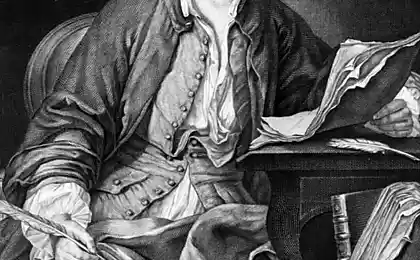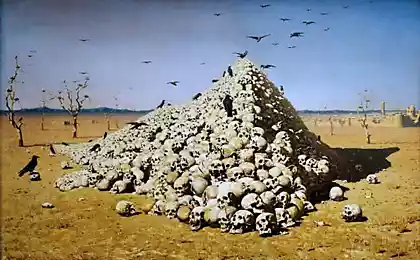1037
Superweapon in the history of mankind
26 photos + video
I do not know what weapons will be carried out World War III. But the main weapon in the Fourth World War will be sticks and stones.
Albert Einstein
Walking tanks, power armor, Gaussian gun, combat suits, atomic homing bullets, underground car-saboteurs, ion cannons on the orbit of the planet is all we have seen in fiction and so is unlikely to be surprised if things suddenly appear in reality. However, for all the bloody history of the 20th century it had created a lot of weapons, which is amazing, even now. There is nothing supernatural, but the audacity of the design plan, the scale of implementation and the destructive power of these instruments of death (by the standards of the time) upstage even the most complex weapons out of science fiction.
This article will not be considered conventional weapons of mass destruction or unrealized superproject - for example, the Soviet space station nuclear missiles on board or American program "Star Wars." Today, you'll learn about the most extraordinary weapons, created in single (or at Merey, piece) counterparts and appear to be more scientific than military interest. Meet them - bulky, unreliable, expensive and incredibly powerful!
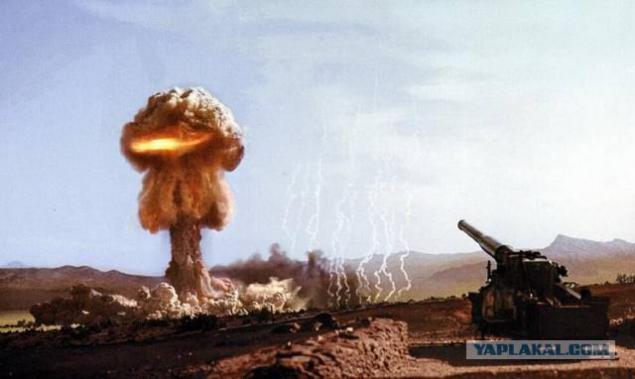
During the reign of King Louis 14 (1661-1715), Cardinal Richelieu ordered to knock on the carriages of the French guns catch phrase "Ultima ratio regum" - "The last argument of kings." Two centuries later, the last argument of the first. During the Russian-Finnish war of 1939-1940, Stalin often quoted phrase "Artillery - the goddess of war," it sounded in the 17th century as the "Artillery - the goddess of fire".
Artillery has not lost its value today. Its development is closely connected with computers - for example, relatively recently emerged technology MRSI (Multiple Rounds Simultaneous Impact - a simultaneous blow of multiple shells), which lies in the fact that the computer controls the high-velocity gun and change the angle of the trunk so that all the shells fired for certain period of time, arrive to the target at the same time.
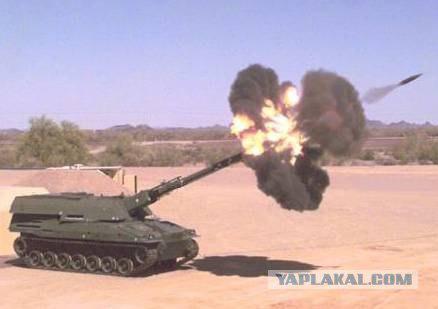
In the history of artillery including practical and effective "war goddess" is sometimes come across such instances to which it was impossible to watch without respectful tremble at the knees.
Among the first to be called "Basilica", or "the Ottoman cannon." It was developed in the 15th century Hungarian gunsmith Urban and differed terrifying power and even more terrifying inaccurate shooting. "Basilica" used great Sultan Mehmed (Muhammad) Second, taking with it the help of Constantinople in 1493 - one of the most well-protected cities of the time.
Giant cannon is very useful - because it was hard to get in anything less than Constantinople, but she was easily able to break through the thick walls of the city. On this, her career was over. Recharging "Basilica" demanded one hour shells were few, and most importantly - the sixth week she collapsed from its own return.
About a hundred years after the creation of "Ottoman cannon", in 1586 Russian master Andrei Chokhov foundry manufactured in Moscow, huge mortar, the world-famous "Tsar Cannon". It weighs 40 tons, reaches a length of 5, 34 meters and has a caliber of 890 millimeters. Carriages and metal core (originally had a gun to shoot the stone) made later in 1835.
Posted in [mergetime] 1243011853 [/ mergetime]
This formidable weapon was intended for the defense of the Kremlin (it is doubtful that a gun is good to deal with it - such tools appropriate to apply only to the destruction of the walls), but never once did not shoot. A distinctive feature of "Tsar Cannon" is its rich decorative relief, including an image of Tsar Fyodor Ivanovich on a horse.
Supergun reminded of themselves during the two World Wars. The first "star" in this area was the "Big Bertha" (It. "Dicke Bertha") - one of the guns models L / 14 used by Germany in the First World.
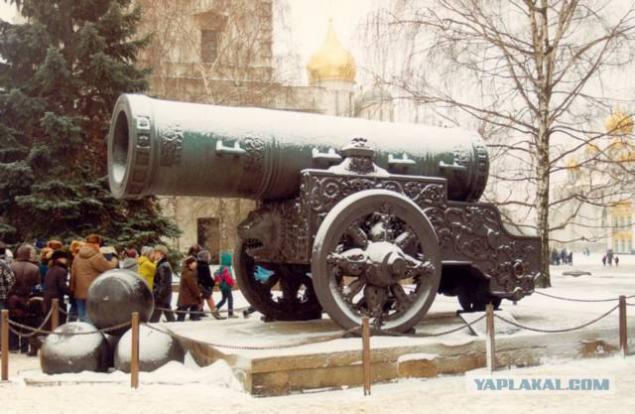
Bertha "was designed in 1904 and built at Krupp in 1914. Its size is 42 cm, weight reached 820 kilograms of shells and firing range - 15 kilometers. Were built four such tools, they all participated in the famous Battle of Verdun in winter 1916 (more than a million dead and wounded).
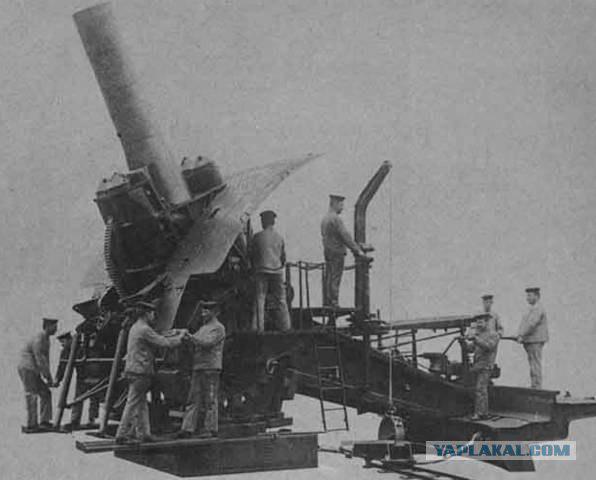
Berta has
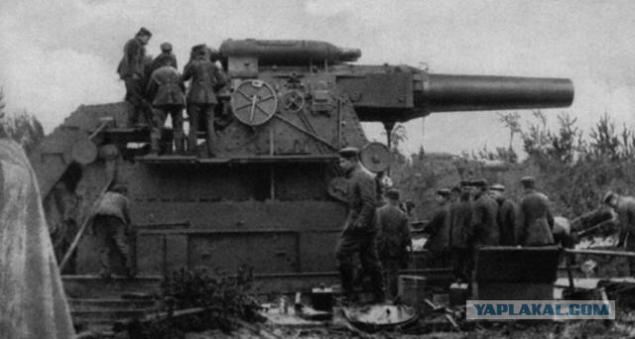
Experience in the use of such tools has inspired the Germans during World War II on the creation of heavy self-propelled "Carl Morser" (one of these monsters fired the first shot of the Brest Fortress, marking the beginning of the war with the Soviet Union) and attack modification of the tank "Tiger" - "Sturmmörser Tiger" with instrument of .38. Total was made 6 "Charles" and assault 18 "Tigers". Survived the war one and two copies, respectively. Now they are on display tank museum in Kubinka (near Moscow).

Sturmmörser Tiger
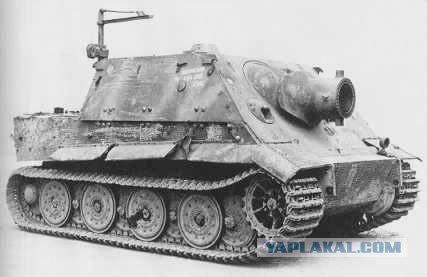
Toward the end of the First World War the Germans suddenly decided that they need to make a really big gun and began firing from her Paris - not only for the destruction of the city, much to intimidate its inhabitants.
No sooner said than done. In March 1918, it came to light a surprising weapon, able to move only by rail (and disassembled) and which bore the name of an unequivocal "Paris Gun." Soldiers sometimes called her "Kaiser Wilhelm". She (or he) was to fight only until August of the same year - affecting the strength of shells was scanty, the trunk had to be changed frequently, and the accuracy of fire just old enough to shell objects such as Paris

even Paris Gun
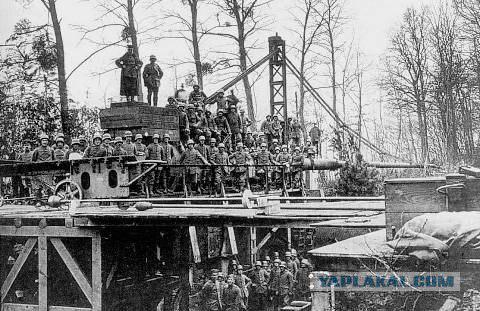
The weight of the projectile was 94 kilograms, the weight of the powder charge - 180 kg, range combat - 130 kilometers, the maximum height of the trajectory - 40 kilometers. Gun crew - 80 people (sailors under the command of Admiral). The gun was hidden in the woods around it have multiple batteries more modest caliber, to create "background noise" - the French were unable to locate the "Paris Gun." The city of projectile flew 170 seconds. The gun itself weighed 256 tons and had a very small for the size of the caliber of 210 millimeters
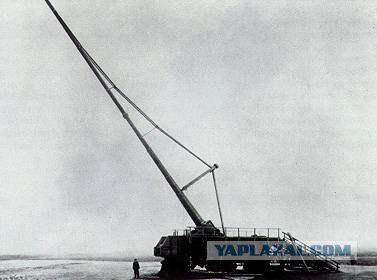
As for the caliber, then "Paris Gun" was another interesting feature. Every shot "erased" from the inside of the metal barrel and caliber became a little bit more. Knowing this, the number practical Germans manufactured shells - from 1 to 65, each of which was a little larger than the previous one. Their release followed in strict sequence, and after the 65th - to change the barrel.
Parisians at first taken aback when they started falling shells, which appeared as if out of nowhere. But the destruction of a whole were small - the most dramatic episode of the summer fire was a direct hit in the church, where the service was - then killed more than 60 people.
After the beginning of a powerful offensive of the Entente in August 1918 the Germans destroyed the "Paris Gun" that she did not get to the enemy. From it survived only a few parts, the Americans found about Chateau Terry
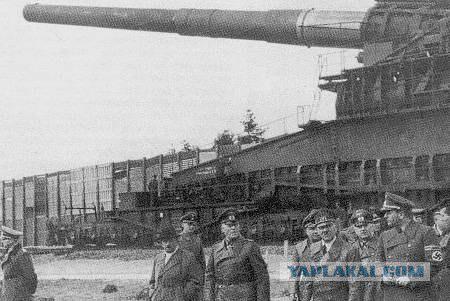
Cannon "Shverer Gustav" ("Schwerer Gustav"), affectionately called gunners "Dora" - the first superorudie World War II, built by the same restless Germans.
Her options are impressive. Weight - 1344 tons of 800 mm caliber, ammunition weight - from 5 to 7, 5 tonnes (depending on type). To service the gun was required 1,500. The minimum interval between shots is 15 minutes. Firing range - 45 kilometers for the explosive shells, and 37 kilometers for the armor.
The diameter of the crater after the explosion of the projectile "Dora" was 10 meters (and as many more in depth). Cannon has also been able to penetrate about 9 meters of reinforced concrete.
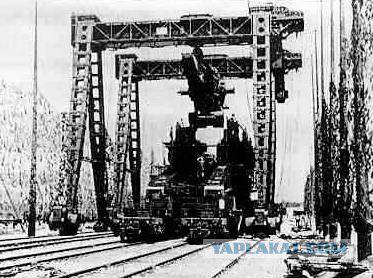
And Gustav

and that its shells))
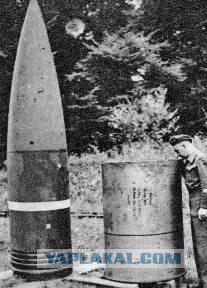
Finally we come to the most incredible combat gun ever made by human hands. This project had a common name V-3 - the third part of "weapons of retaliation" ("Vergeltungswaffe"), created by the Nazis desperately at the end of World War II (V-1 and V-2 were flying bombs and rockets, respectively).
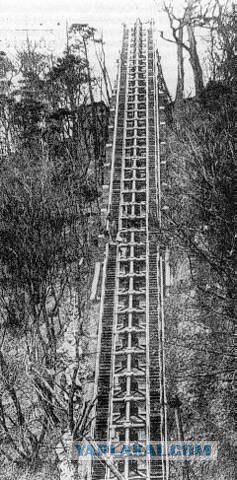
Construction of V-3. Between the wooden stairs on the slope of a hill laid the gun barrel with side chambers
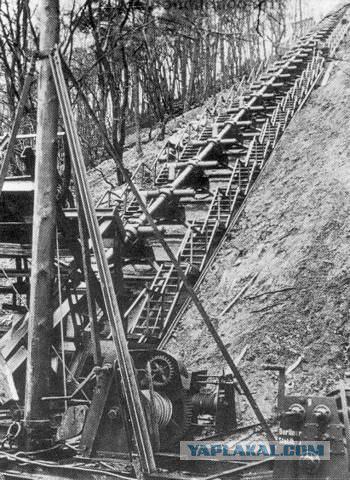
Codename V-3 was "Hochdruckpumpe" (it. - "High pressure pump"). The project had only one goal - the destruction of London in retaliation for the Allied air raids on Germany.
Gun complex housed in an underground bunker near Maymoskusa (France). It consisted of five independent panels, each of which had one supergaubitse length of 140 meters (150 mm gauge), capable of delivering a projectile mass of 140 kg over a distance of 165 (!) Kilometers.
This is a fantastic long range achieved through the special design of the barrel. Along it were placed cameras with additional charges of explosives that ignited just at the moment when they passed by the shell. Rate the entire complex it was also very high - up to 300 shots per hour.

Works in Maymoskuse began in September 1943. Hundreds of workers (the vast majority of whom were prisoners of concentration camps) tunnel dug into the hill depth of 30 meters and is equipped bunker there, covered a five-meter thick layer of concrete.
The Allies quickly learned about it. Two months later, they began raids, but even Five-ton bombs could not penetrate the bunker, defended gun.
The weapon was almost ready when the July 6, 1944 Three of the famous British bomber squadron №612 "Fuses dams" (their coat of arms adorned the destruction of dams, through which water gushes, with the motto: "After us - the deluge only!") Broke through German air defense and, figuratively speaking, repeated the feat of Luke Skywalker - going at the minimum height, one of them was able to get extra heavy bomb "Tallboy" ("big man") in the open pit silo. The blast occurred at a depth of 30 meters, the entire staff and all the workers were killed. Gun complex suffered so much that it was not subject to restoration
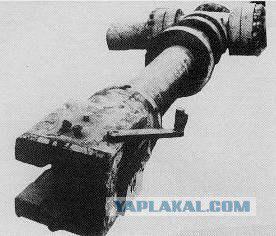
In 1961, when the US-Canada launched a project HARP ("High Altitude Research Project" - "Project high-altitude research"). It was originally implemented as part of the study of the behavior of ballistic objects in the upper atmosphere. But then he became interested in the military, which raised the possibility of a rapid withdrawal of satellites in low orbits (there were also rumors that this gun was planned to shoot down alien satellites).
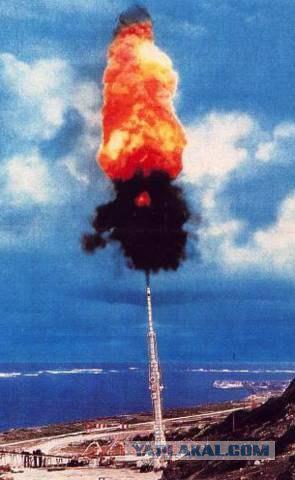
Soul project was a Canadian engineer Gerald Bull ballistics - a weirdo, but certainly talented. Story HARP very difficult - Bull constantly had to "knock out" of the governments of the US and Canada money for another modification of their guns.
It was built more than a dozen guns HARP. They had a different caliber and located across North America - from Arizona to Quebec. The culmination of the project was the 16-inch (40, 6 centimeters) gun mounted in Barbados (Caribbean). Its length reaches 40 meters, weight shells - 180 kg, the initial velocity - 3600 meters per second. Cannon threw them at the height of 180 kilometers, after which they fell into the ocean.
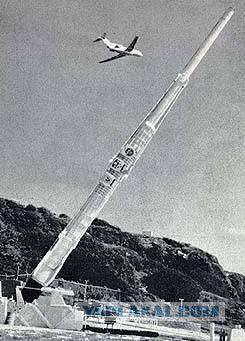
That was, of course, is not enough to bring satellites in constant orbit. However, the team has developed the Bull-missile missiles "Marlet", which, when released from the gun can deliver into orbit a small satellite.
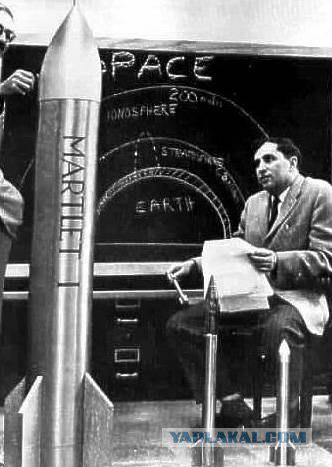
In 1967, funding for the project has stopped, it was closed. Gerald Bull despair so much that in 1988 he accepted an offer of Saddam Hussein's Iraq to build supergun. This project was named "Babel" (official cover - construction of an oil of PC-2). According to him, Bull had to design two guns - large, with the caliber of 1000 millimeters, and "Small Babylon" with a caliber of 350 millimeters. The amount of remuneration engineer was 25 million. Dollars. The official purpose of "Babylon" - the satellite into orbit. According to calculations of Bull, it would have cost only 600 dollars per kilogram. Informal - shelling of neighboring countries, namely Iran and Kuwait. Defectors from Iraq claimed that Hussein wants to use in its chemical, biological and even nuclear warheads. It was said also that he was planning to churn out this gun enemy satellites.
According to their data, "Babylon" was approaching the German V-3. The length of the big gun is 156 meters. The wall thickness of the barrel - 30 cm at the base, 6, 5 cm from the muzzle. Total weight - 1510 tons. Weight of explosives - 9 tons. The gun could produce 600-kilogram bombs (or 2,000-pound rockets) at a distance of 1,000 kilometers. The impact of its shots for the calculations was like an earthquake - it can be recorded around the globe.
In 1989, in the village of Jabal Hanrayam (145 km from Baghdad) was built "Small Babylon" length 45 meters. Spare parts for it came from the UK under false labels "oil pipes PC-2". Western intelligence agencies were aware of what is happening, but "Babel" did not disturb them. It has all the disadvantages of V-3 - stationary cannon could be directed in only one direction and is an easy target for aviation.
The "Babylon" ended tragically. In the evening, March 22, 1990, Gerald Bull, opens the door to his apartment in Brussels, he received six shots in the back. Its elimination is suspected Israeli intelligence. Later, August 2, Iraq invaded Kuwait. This was followed by the response of the West - the delivery of spare parts for "Babylon" stopped, and after the war, all the achievements of the project were destroyed.
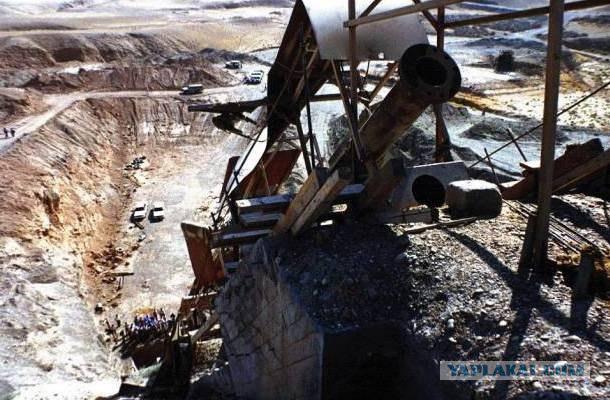
Whatever may have been impressive giant cannon, the real power still rests with the missiles and bombs, in particular - nuclear. During the Cold War created such grotesque examples of such weapons, which are now very difficult to imagine their real power.
The most famous was the Soviet "Tsar-bomb" (the code name for the project - "Ivan"), a thermonuclear charge capacity of about 50 megatons. We know that Nikita Khrushchev ordered Academician Kurchatov "cracker" of 100 megatons, but the power of the test device has been reduced by half. This, however, did not prevent Khrushchev to declare that the Soviet Union was successfully detonated stomegatonnaya "Tsar-bomb".

Whatever may have been impressive giant cannon, the real power still rests with the missiles and bombs, in particular - nuclear. During the Cold War created such grotesque examples of such weapons, which are now very difficult to imagine their real power.
The most famous was the Soviet "Tsar-bomb" (the code name for the project - "Ivan"), a thermonuclear charge capacity of about 50 megatons. We know that Nikita Khrushchev ordered Academician Kurchatov "cracker" of 100 megatons, but the power of the test device has been reduced by half. This, however, did not prevent Khrushchev to declare that the Soviet Union was successfully detonated stomegatonnaya "Tsar-bomb".
"Tsar-bomb" was the most powerful energy device ever powered people. Its charge was 50 Mt equals 2 1h1017 joules, i.e. 5 3h1024 watts or 5, 3 yottavatt. To help you understand what is at stake - it is more than one percent of the Sun's energy allocated to them for one second.
The important thing was that the thermonuclear bomb was relatively "clean" - uranium shell charge was replaced by lead, so 90% of the energy passed by nuclear fusion rather than fission. Otherwise radioactive contamination would incur huge area around the landfill.
"Tsar-bomb" was exploded on Oct. 30, 1961 in the New Earth. Tu-95 came to a height of 10,500 meters and dropped the "Ivan" at a given point. The detonation occurred three minutes later, at an altitude of about 4000 meters. By this time, the plane had to move away to a distance of 45 kilometers.
Fireball erupted reached about the same height from which it was produced bombing. The consequences of the explosion indescribable: the flash was observed even at 1,000 kilometers from the landfill. The characteristic "mushroom" long formed, and then reached a height of 15 kilometers and 30-40 kilometers wide. Blast Wave walked three times around the Earth. According to specialists, all the people in a radius of 100 kilometers from the explosion would have received third-degree burns (70% damage to the skin).
The feasibility of the real use of such weapons in war is still being discussed. Many believe that in order to achieve strategic advantage is much more efficient to use a somewhat more modest nuclear warheads than burn every living thing for hundreds of kilometers around. Theoretically, such a powerful charge could be detonated under water off the coast of the United States - formed in this case, the wave can wash away all the east coast.
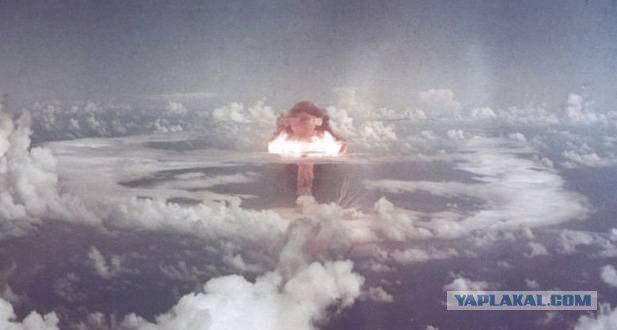
Source:
I do not know what weapons will be carried out World War III. But the main weapon in the Fourth World War will be sticks and stones.
Albert Einstein
Walking tanks, power armor, Gaussian gun, combat suits, atomic homing bullets, underground car-saboteurs, ion cannons on the orbit of the planet is all we have seen in fiction and so is unlikely to be surprised if things suddenly appear in reality. However, for all the bloody history of the 20th century it had created a lot of weapons, which is amazing, even now. There is nothing supernatural, but the audacity of the design plan, the scale of implementation and the destructive power of these instruments of death (by the standards of the time) upstage even the most complex weapons out of science fiction.
This article will not be considered conventional weapons of mass destruction or unrealized superproject - for example, the Soviet space station nuclear missiles on board or American program "Star Wars." Today, you'll learn about the most extraordinary weapons, created in single (or at Merey, piece) counterparts and appear to be more scientific than military interest. Meet them - bulky, unreliable, expensive and incredibly powerful!

During the reign of King Louis 14 (1661-1715), Cardinal Richelieu ordered to knock on the carriages of the French guns catch phrase "Ultima ratio regum" - "The last argument of kings." Two centuries later, the last argument of the first. During the Russian-Finnish war of 1939-1940, Stalin often quoted phrase "Artillery - the goddess of war," it sounded in the 17th century as the "Artillery - the goddess of fire".
Artillery has not lost its value today. Its development is closely connected with computers - for example, relatively recently emerged technology MRSI (Multiple Rounds Simultaneous Impact - a simultaneous blow of multiple shells), which lies in the fact that the computer controls the high-velocity gun and change the angle of the trunk so that all the shells fired for certain period of time, arrive to the target at the same time.

In the history of artillery including practical and effective "war goddess" is sometimes come across such instances to which it was impossible to watch without respectful tremble at the knees.
Among the first to be called "Basilica", or "the Ottoman cannon." It was developed in the 15th century Hungarian gunsmith Urban and differed terrifying power and even more terrifying inaccurate shooting. "Basilica" used great Sultan Mehmed (Muhammad) Second, taking with it the help of Constantinople in 1493 - one of the most well-protected cities of the time.
Giant cannon is very useful - because it was hard to get in anything less than Constantinople, but she was easily able to break through the thick walls of the city. On this, her career was over. Recharging "Basilica" demanded one hour shells were few, and most importantly - the sixth week she collapsed from its own return.
About a hundred years after the creation of "Ottoman cannon", in 1586 Russian master Andrei Chokhov foundry manufactured in Moscow, huge mortar, the world-famous "Tsar Cannon". It weighs 40 tons, reaches a length of 5, 34 meters and has a caliber of 890 millimeters. Carriages and metal core (originally had a gun to shoot the stone) made later in 1835.
Posted in [mergetime] 1243011853 [/ mergetime]
This formidable weapon was intended for the defense of the Kremlin (it is doubtful that a gun is good to deal with it - such tools appropriate to apply only to the destruction of the walls), but never once did not shoot. A distinctive feature of "Tsar Cannon" is its rich decorative relief, including an image of Tsar Fyodor Ivanovich on a horse.
Supergun reminded of themselves during the two World Wars. The first "star" in this area was the "Big Bertha" (It. "Dicke Bertha") - one of the guns models L / 14 used by Germany in the First World.

Bertha "was designed in 1904 and built at Krupp in 1914. Its size is 42 cm, weight reached 820 kilograms of shells and firing range - 15 kilometers. Were built four such tools, they all participated in the famous Battle of Verdun in winter 1916 (more than a million dead and wounded).

Berta has

Experience in the use of such tools has inspired the Germans during World War II on the creation of heavy self-propelled "Carl Morser" (one of these monsters fired the first shot of the Brest Fortress, marking the beginning of the war with the Soviet Union) and attack modification of the tank "Tiger" - "Sturmmörser Tiger" with instrument of .38. Total was made 6 "Charles" and assault 18 "Tigers". Survived the war one and two copies, respectively. Now they are on display tank museum in Kubinka (near Moscow).

Sturmmörser Tiger

Toward the end of the First World War the Germans suddenly decided that they need to make a really big gun and began firing from her Paris - not only for the destruction of the city, much to intimidate its inhabitants.
No sooner said than done. In March 1918, it came to light a surprising weapon, able to move only by rail (and disassembled) and which bore the name of an unequivocal "Paris Gun." Soldiers sometimes called her "Kaiser Wilhelm". She (or he) was to fight only until August of the same year - affecting the strength of shells was scanty, the trunk had to be changed frequently, and the accuracy of fire just old enough to shell objects such as Paris

even Paris Gun

The weight of the projectile was 94 kilograms, the weight of the powder charge - 180 kg, range combat - 130 kilometers, the maximum height of the trajectory - 40 kilometers. Gun crew - 80 people (sailors under the command of Admiral). The gun was hidden in the woods around it have multiple batteries more modest caliber, to create "background noise" - the French were unable to locate the "Paris Gun." The city of projectile flew 170 seconds. The gun itself weighed 256 tons and had a very small for the size of the caliber of 210 millimeters

As for the caliber, then "Paris Gun" was another interesting feature. Every shot "erased" from the inside of the metal barrel and caliber became a little bit more. Knowing this, the number practical Germans manufactured shells - from 1 to 65, each of which was a little larger than the previous one. Their release followed in strict sequence, and after the 65th - to change the barrel.
Parisians at first taken aback when they started falling shells, which appeared as if out of nowhere. But the destruction of a whole were small - the most dramatic episode of the summer fire was a direct hit in the church, where the service was - then killed more than 60 people.
After the beginning of a powerful offensive of the Entente in August 1918 the Germans destroyed the "Paris Gun" that she did not get to the enemy. From it survived only a few parts, the Americans found about Chateau Terry

Cannon "Shverer Gustav" ("Schwerer Gustav"), affectionately called gunners "Dora" - the first superorudie World War II, built by the same restless Germans.
Her options are impressive. Weight - 1344 tons of 800 mm caliber, ammunition weight - from 5 to 7, 5 tonnes (depending on type). To service the gun was required 1,500. The minimum interval between shots is 15 minutes. Firing range - 45 kilometers for the explosive shells, and 37 kilometers for the armor.
The diameter of the crater after the explosion of the projectile "Dora" was 10 meters (and as many more in depth). Cannon has also been able to penetrate about 9 meters of reinforced concrete.

And Gustav

and that its shells))

Finally we come to the most incredible combat gun ever made by human hands. This project had a common name V-3 - the third part of "weapons of retaliation" ("Vergeltungswaffe"), created by the Nazis desperately at the end of World War II (V-1 and V-2 were flying bombs and rockets, respectively).

Construction of V-3. Between the wooden stairs on the slope of a hill laid the gun barrel with side chambers

Codename V-3 was "Hochdruckpumpe" (it. - "High pressure pump"). The project had only one goal - the destruction of London in retaliation for the Allied air raids on Germany.
Gun complex housed in an underground bunker near Maymoskusa (France). It consisted of five independent panels, each of which had one supergaubitse length of 140 meters (150 mm gauge), capable of delivering a projectile mass of 140 kg over a distance of 165 (!) Kilometers.
This is a fantastic long range achieved through the special design of the barrel. Along it were placed cameras with additional charges of explosives that ignited just at the moment when they passed by the shell. Rate the entire complex it was also very high - up to 300 shots per hour.

Works in Maymoskuse began in September 1943. Hundreds of workers (the vast majority of whom were prisoners of concentration camps) tunnel dug into the hill depth of 30 meters and is equipped bunker there, covered a five-meter thick layer of concrete.
The Allies quickly learned about it. Two months later, they began raids, but even Five-ton bombs could not penetrate the bunker, defended gun.
The weapon was almost ready when the July 6, 1944 Three of the famous British bomber squadron №612 "Fuses dams" (their coat of arms adorned the destruction of dams, through which water gushes, with the motto: "After us - the deluge only!") Broke through German air defense and, figuratively speaking, repeated the feat of Luke Skywalker - going at the minimum height, one of them was able to get extra heavy bomb "Tallboy" ("big man") in the open pit silo. The blast occurred at a depth of 30 meters, the entire staff and all the workers were killed. Gun complex suffered so much that it was not subject to restoration

In 1961, when the US-Canada launched a project HARP ("High Altitude Research Project" - "Project high-altitude research"). It was originally implemented as part of the study of the behavior of ballistic objects in the upper atmosphere. But then he became interested in the military, which raised the possibility of a rapid withdrawal of satellites in low orbits (there were also rumors that this gun was planned to shoot down alien satellites).

Soul project was a Canadian engineer Gerald Bull ballistics - a weirdo, but certainly talented. Story HARP very difficult - Bull constantly had to "knock out" of the governments of the US and Canada money for another modification of their guns.
It was built more than a dozen guns HARP. They had a different caliber and located across North America - from Arizona to Quebec. The culmination of the project was the 16-inch (40, 6 centimeters) gun mounted in Barbados (Caribbean). Its length reaches 40 meters, weight shells - 180 kg, the initial velocity - 3600 meters per second. Cannon threw them at the height of 180 kilometers, after which they fell into the ocean.

That was, of course, is not enough to bring satellites in constant orbit. However, the team has developed the Bull-missile missiles "Marlet", which, when released from the gun can deliver into orbit a small satellite.

In 1967, funding for the project has stopped, it was closed. Gerald Bull despair so much that in 1988 he accepted an offer of Saddam Hussein's Iraq to build supergun. This project was named "Babel" (official cover - construction of an oil of PC-2). According to him, Bull had to design two guns - large, with the caliber of 1000 millimeters, and "Small Babylon" with a caliber of 350 millimeters. The amount of remuneration engineer was 25 million. Dollars. The official purpose of "Babylon" - the satellite into orbit. According to calculations of Bull, it would have cost only 600 dollars per kilogram. Informal - shelling of neighboring countries, namely Iran and Kuwait. Defectors from Iraq claimed that Hussein wants to use in its chemical, biological and even nuclear warheads. It was said also that he was planning to churn out this gun enemy satellites.
According to their data, "Babylon" was approaching the German V-3. The length of the big gun is 156 meters. The wall thickness of the barrel - 30 cm at the base, 6, 5 cm from the muzzle. Total weight - 1510 tons. Weight of explosives - 9 tons. The gun could produce 600-kilogram bombs (or 2,000-pound rockets) at a distance of 1,000 kilometers. The impact of its shots for the calculations was like an earthquake - it can be recorded around the globe.
In 1989, in the village of Jabal Hanrayam (145 km from Baghdad) was built "Small Babylon" length 45 meters. Spare parts for it came from the UK under false labels "oil pipes PC-2". Western intelligence agencies were aware of what is happening, but "Babel" did not disturb them. It has all the disadvantages of V-3 - stationary cannon could be directed in only one direction and is an easy target for aviation.
The "Babylon" ended tragically. In the evening, March 22, 1990, Gerald Bull, opens the door to his apartment in Brussels, he received six shots in the back. Its elimination is suspected Israeli intelligence. Later, August 2, Iraq invaded Kuwait. This was followed by the response of the West - the delivery of spare parts for "Babylon" stopped, and after the war, all the achievements of the project were destroyed.

Whatever may have been impressive giant cannon, the real power still rests with the missiles and bombs, in particular - nuclear. During the Cold War created such grotesque examples of such weapons, which are now very difficult to imagine their real power.
The most famous was the Soviet "Tsar-bomb" (the code name for the project - "Ivan"), a thermonuclear charge capacity of about 50 megatons. We know that Nikita Khrushchev ordered Academician Kurchatov "cracker" of 100 megatons, but the power of the test device has been reduced by half. This, however, did not prevent Khrushchev to declare that the Soviet Union was successfully detonated stomegatonnaya "Tsar-bomb".

Whatever may have been impressive giant cannon, the real power still rests with the missiles and bombs, in particular - nuclear. During the Cold War created such grotesque examples of such weapons, which are now very difficult to imagine their real power.
The most famous was the Soviet "Tsar-bomb" (the code name for the project - "Ivan"), a thermonuclear charge capacity of about 50 megatons. We know that Nikita Khrushchev ordered Academician Kurchatov "cracker" of 100 megatons, but the power of the test device has been reduced by half. This, however, did not prevent Khrushchev to declare that the Soviet Union was successfully detonated stomegatonnaya "Tsar-bomb".
"Tsar-bomb" was the most powerful energy device ever powered people. Its charge was 50 Mt equals 2 1h1017 joules, i.e. 5 3h1024 watts or 5, 3 yottavatt. To help you understand what is at stake - it is more than one percent of the Sun's energy allocated to them for one second.
The important thing was that the thermonuclear bomb was relatively "clean" - uranium shell charge was replaced by lead, so 90% of the energy passed by nuclear fusion rather than fission. Otherwise radioactive contamination would incur huge area around the landfill.
"Tsar-bomb" was exploded on Oct. 30, 1961 in the New Earth. Tu-95 came to a height of 10,500 meters and dropped the "Ivan" at a given point. The detonation occurred three minutes later, at an altitude of about 4000 meters. By this time, the plane had to move away to a distance of 45 kilometers.
Fireball erupted reached about the same height from which it was produced bombing. The consequences of the explosion indescribable: the flash was observed even at 1,000 kilometers from the landfill. The characteristic "mushroom" long formed, and then reached a height of 15 kilometers and 30-40 kilometers wide. Blast Wave walked three times around the Earth. According to specialists, all the people in a radius of 100 kilometers from the explosion would have received third-degree burns (70% damage to the skin).
The feasibility of the real use of such weapons in war is still being discussed. Many believe that in order to achieve strategic advantage is much more efficient to use a somewhat more modest nuclear warheads than burn every living thing for hundreds of kilometers around. Theoretically, such a powerful charge could be detonated under water off the coast of the United States - formed in this case, the wave can wash away all the east coast.

Source:







